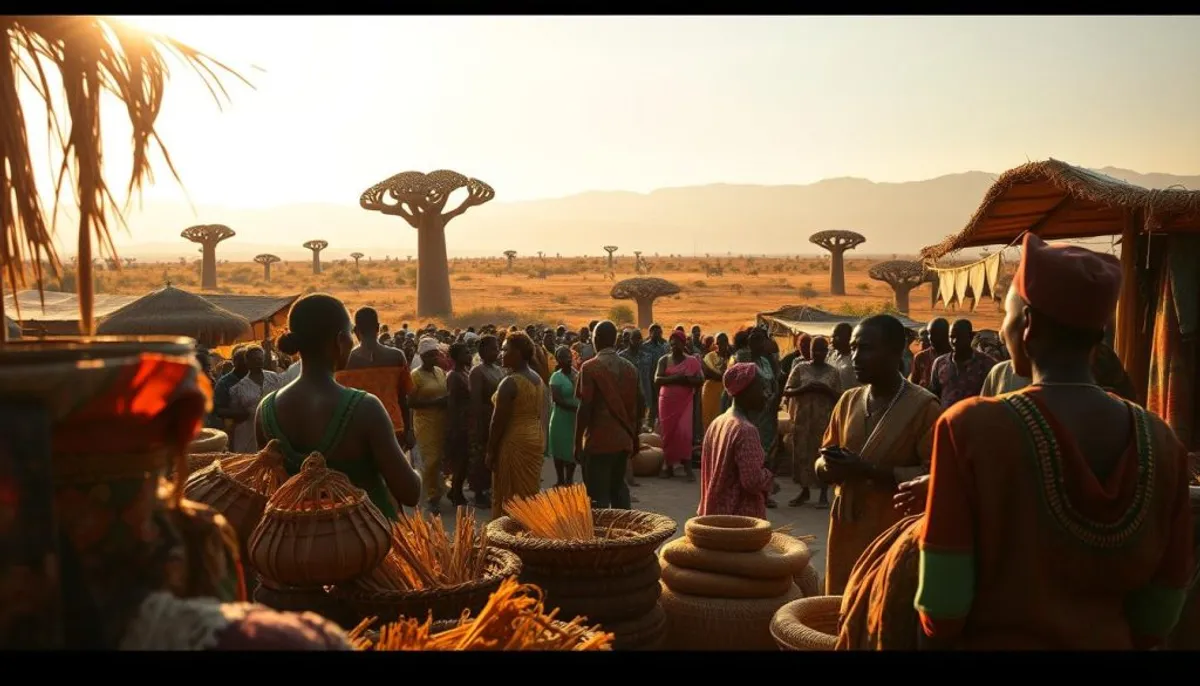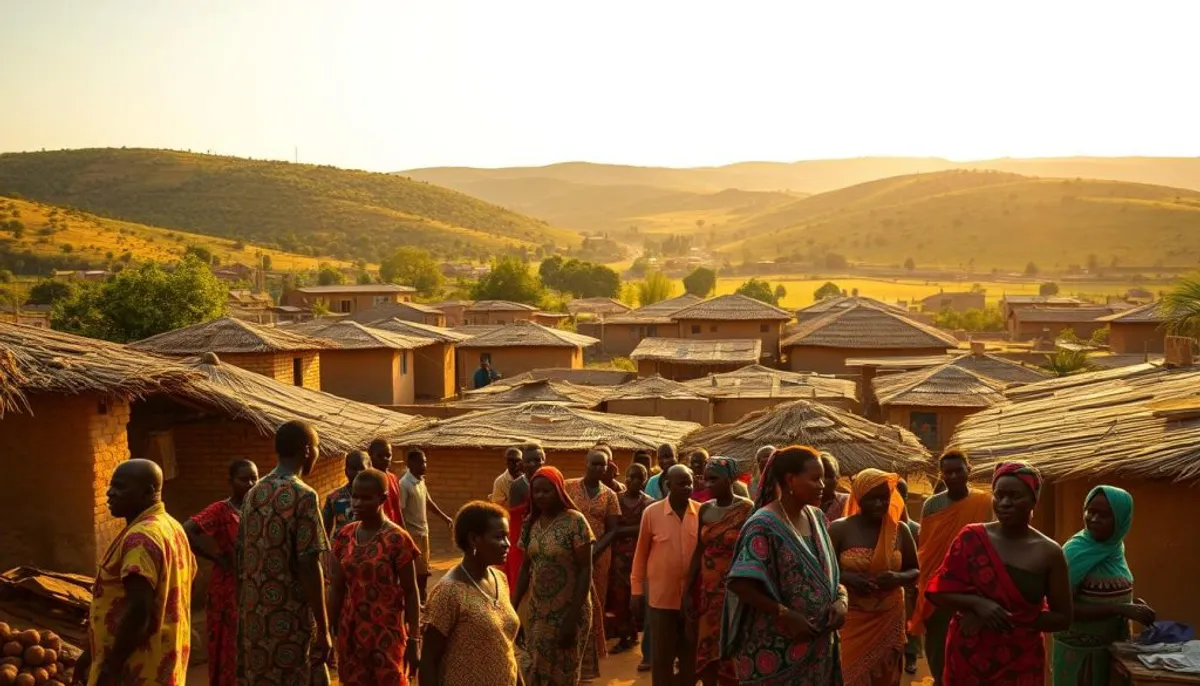West Africa is a cultural goldmine. It showcases a variety of traditions and a deep history. From masks to rhythms, everything is rich and diverse.

A recent exhibition, “Africa, Heritage and Traditions,” revealed 80 unique pieces. From February 11 to May 13, 2023, it offered visitors a chance to discover figurines. These represent spirits, ancestors, and deities from the Dogon, Dan, Baoule, Yoruba, Bambara, and Gouro cultures.
African cuisine is also a reflection of its culture. Rooted in ancient Egypt, it uses local ingredients such as millet and sorghum. African chefs value these elements to preserve their culinary heritage.
The Artistic Heritage of West Africa
The art of West Africa is a true cultural treasure. Over the centuries, the civilizations of this region have created a rich and diverse artistic heritage. This unique heritage reflects the creativity and spirituality of the peoples of this region.
Traditional Art and Its Sacred Symbolism
Traditional art of West Africa is deeply rooted in spiritual beliefs. Artists bring depth to their work, as seen in the “White Lady,” a rock painting dating back to 4000 BCE. These works reflect the cosmology and values of the societies that created them.
Masks and Figurines: Witnesses of a Millennia-Old History
Masks and figurines play a central role in the art of West Africa. They tell the story of the civilizations of this region through the ages. For example, the female figurine from the Djenné culture, dated between the 13th and 15th centuries, showcases the skill of artisans of the time.
Contemporary Craftsmanship and Its Evolutions
The craftsmanship of West Africa continues to evolve while keeping its roots. Modern artisans draw inspiration from ancestral techniques to create unique works. The dynamism of this art is reflected in events like the Dakar Biennale, launched in 1990, which highlights contemporary African art.
| Work | Period | Dimension |
|---|---|---|
| White Lady (rock art) | 4000 BCE | 100 × 150 cm |
| Djenné Figurine | 13th – 15th century | 37.5 cm |
| Kwele Mask | Early 20th century | 63 cm |
West African Culture Through Its Musical Expressions
West African music presents itself as an unparalleled sound wealth. From the dynamic rhythms of mbalax to the hypnotic melodies of the kora, each note is a narrative. This musical variety illustrates the cultural depth of the region. For those looking to deepen their knowledge, ap french resources are available to explore this wealth even further.
Mbalax and Traditional Rhythms
Mbalax, a flagship musical genre from Senegal, embodies the essence of West African music. Its captivating rhythms encourage dance, celebrating the essence of life. Other styles, such as Peul music, stand out with their distinctive rhythms and songs.

Iconic Instruments: From the Djembe to the Kora
Traditional instruments play an essential role in West African music. The djembe, an iconic drum, joins other instruments like the sabar and the kora. The imzad, played by Tuareg women, and the tidnit, reserved for men, showcase the instrumental diversity of the region.
| Instrument | Origin | Characteristic |
|---|---|---|
| Imzad | Tuareg | String instrument played only by women |
| Tehardent | Mali and Niger | Three-string lute used by the Tuaregs |
| Tidnit | Mauritania | Instrument reserved for men, related to the N’Goni |
The Role of Griots in Cultural Transmission
Griots, guardians of oral tradition, are essential for the preservation of West African culture. They transmit history and wisdom through their music and stories. In Mauritania, the music of the griots iggawin develops according to three cycles of modes, enriching West African literature with their songs and poems.
Traditions and Ethnic Diversity in West Africa
West Africa is a true tapestry of cultures, reflecting the depth of West African traditions. With a population of over 320 million people, it spans 6.14 million km². This region is a true mirror of the diversity of West African civilizations.
The Wealth of Languages and Dialects
Linguistic diversity is a pillar of West African culture. Senegal, for example, showcases this variety with French and Wolof as official languages. Many local dialects complement this linguistic richness. This linguistic plurality is an asset for preserving cultural identities, just like studies in arts and culture that enrich our understanding of these dynamics.
Ancestral Ceremonies and Rituals
West African traditions manifest through numerous ceremonies and rituals. These practices, passed down from generation to generation, are essential to daily life. They mark important life stages, strengthen community ties, and perpetuate traditional values. Moreover, they may include educational activities for children designed to transmit these values to the younger generation.
The Importance of “Téranga” and Hospitality
The “Téranga,” a central concept of West African culture, embodies the legendary hospitality of the region. This value, deeply rooted in traditions, is manifested through a warm welcome for visitors. It reflects the importance of human relationships in West African societies.
| Country | Area (km²) | Population (2012) | Density (inhabitants/km²) |
|---|---|---|---|
| Nigeria | 923,768 | 166,629,000 | 180 |
| Ghana | 238,533 | 25,546,000 | 107 |
| Côte d'Ivoire | 322,463 | 20,595,000 | 64 |
| Senegal | 196,722 | 13,108,000 | 67 |
This ethnic and cultural diversity, illustrated by these demographic data, forms the foundation of West African traditions. It nourishes a unique regional identity, where each group contributes to the richness of West African culture. To better understand these traditions, it is essential to consult the kadeos map usage guide.

The Religious and Spiritual Heritage
Religion in West Africa is a complex fabric, intertwining ancient traditions and modern influences. Islam, Christianity, and traditional African religions coexist harmoniously, shaping a unique spiritual landscape. This diversity illustrates the depth of African history and its ability to assimilate various cultures.
Traditional African religions (TAR) play a crucial role in the culture of the region. Nearly 90% of traditional African cultures pay homage to ancestors and spirits. These beliefs deeply shape the art, music, and literature of Africa.
Islam and Christianity have also marked history. Between 1978 and 2004, the number of Catholics in Africa exploded, reaching 149 million. Islam, for its part, has integrated into local cultures, giving rise to a distinct “Black Islam” separate from Arab Islam.
- 75% of communities in sub-Saharan Africa recognize reincarnation practices
- 80% of African religious traditions include a rite of passage
- 90% of TAR believe in a supreme God, despite the diversity of practices
Religious tolerance is a notable characteristic of West African society. This peaceful coexistence enriches the culture of the region, demonstrating its ability to value spiritual diversity.
Conclusion
Our exploration of West African culture reveals a rich and evolving heritage. West African art, ranging from traditional masks to contemporary works, illustrates an inexhaustible creativity. The traditions, rooted in remarkable ethnic diversity, continue to shape our daily lives.
Music, with its captivating rhythms and unique instruments, serves as a pillar of cultural expression. It adapts to modern influences while preserving its essence. Spirituality, whether traditional or imported, deeply permeates society, creating a varied and dynamic religious landscape.
In the face of globalization challenges, West African culture demonstrates its resilience. The arrival of international chains like KFC, with 925 restaurants opened in sub-Saharan Africa in 2015, illustrates this adaptation. The growing cosmopolitanism of African cities, attracting individuals from around the world, further enriches this cultural mosaic.
By exploring West African culture, we discover a living heritage that inspires and amazes. Its influence extends far beyond its borders, enriching the global heritage. Whether through travel, reading, or encounters, the invitation to delve deeper into this fascinating culture remains open to all.
RelatedRelated articles


